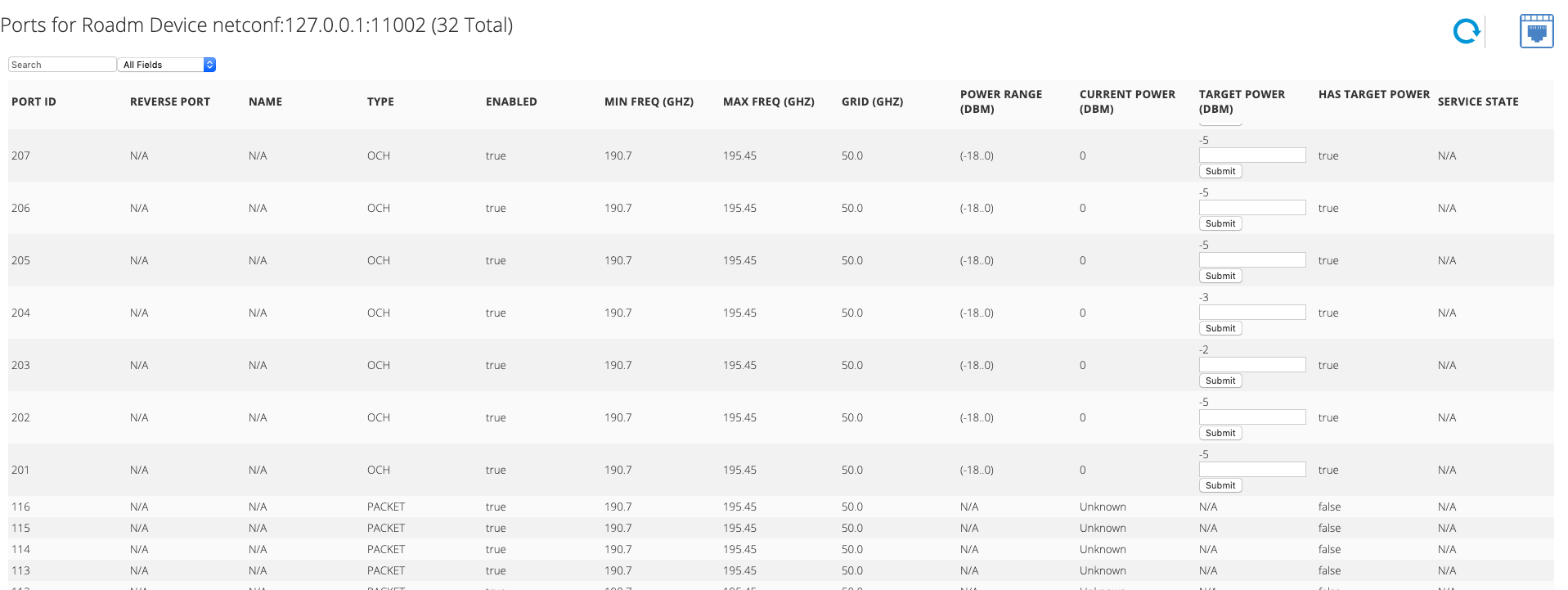This page describe how to execute <get> and <edit-config> operations about "target-output-power" XML node via Netconf. There are totally three ways to config power.
| Table of Contents |
|---|
1. Environment Requirement
- Docker container that runs a Netconf server. Follow the instructions posted How to build and run ODTN Emulators?
- netconf-console tool that is a simulation tool for Netconf client.
- "target-output-power" node defined in "openconfig-terminal-device.yang" as the operation target node.
- Running ONOS instance that is able to configure power through two ways.
...
| Code Block | ||||
|---|---|---|---|---|
| ||||
CONTAINER ID IMAGE COMMAND CREATED STATUS PORTS NAMES 20c0298eb652 onosproject/oc-cassini:0.21 "sh /root/script/pus…" 2 hours ago Up 2 hours 22/tcp, 8080/tcp, 0.0.0.0:11002->830/tcp odtn-emulator_openconfig_cassini_1_1 |
2 Execute Operations
2.1 ONOS startup and node discovery
This section is the environment for section 2.3 and 2.4.
...
| Code Block |
|---|
Welcome to Open Network Operating System (ONOS)!
____ _ ______ ____
/ __ \/ |/ / __ \/ __/
/ /_/ / / /_/ /\ \
\____/_/|_/\____/___/
Documentation: wiki.onosproject.org
Tutorials: tutorials.onosproject.org
Mailing lists: lists.onosproject.org
Come help out! Find out how at: contribute.onosproject.org
Hit '<tab>' for a list of available commands
and '[cmd] --help' for help on a specific command.
Hit '<ctrl-d>' or type 'logout' to exit ONOS session.
onf@root > devices 11:54:09
id=netconf:127.0.0.1:11002, available=true, local-status=connected 4m53s ago, role=MASTER, type=TERMINAL_DEVICE, mfr=EDGECORE, hw=Cassini, sw=OcNOS, serial=, chassis=1, driver=cassini-ocnos, ipaddress=127.0.0.1, locType=none, name=cassini2, port=11002, protocol=NETCONF |
2.2 Config Power by using ONOS CLI Command "power-config"
An ONOS command is provided to configure the power of line-side ports.
...
| Code Block |
|---|
onf@root > power-config 11:56:43 get lock unlock get-config copy-config edit-config kill-session close-session delete-config |
2.2.1 Perform <get> Operation
Through power-config command, you can get the power value of any line-side port of any optical device, for example,
| Code Block |
|---|
onf@root > power-config get netconf:127.0.0.1:11002/216 11:56:43 The target-output-power value in port 216 on device netconf:127.0.0.1:11002 is -2. |
2.2.2 Perform <edit-config> Operation
Through power-config command, you can modify the power value of any line-side port of any optical device, for example,
| Code Block |
|---|
onf@root > power-config edit-config netconf:127.0.0.1:11002/216 -4 12:04:11 onf@root > power-config get netconf:127.0.0.1:11002/216 12:06:01 The target-output-power value in port 216 on device netconf:127.0.0.1:11002 is -4. |
2.3 Config Power on
...
Apart from configuring the power in ONOS CLI, the customer view of roadm application also provides the button to do that.
Firstly, we use command "onos localhost app activate roadm" to activate roadm application. Then, open the roadm page http://localhost:8181/onos/ui/#/roadm-gui:
Select one device netconf:127.0.0.1:11002, and click the port icon on the right-top corner, then you can edit the power of its line-side ports on port page http://localhost:8181/onos/ui/#/roadm-gui/roadm-port-gui?devId=netconf:127.0.0.1:11002. The client-side ports couldn't be edited (see port 116).
...
a single device by using Netconf tool like netconf-console
So we use the command listed below to send RPC request to the container:
...
The root node of "openconfig-platform.yang" is "<components>" and its sublist "<component>" contains "<name>" node as its identity. Besides "openconfig-terminal-device.yang" adds node "<optical-channel>" into "<component>" node. "<target-power-config>" is defined as a child node of "<optical-channel>".
2.3.1 Perform <get> Operation
If you want to get the whole components, the content of get-components is:
...
| Code Block | ||||
|---|---|---|---|---|
| ||||
<nc:rpc-reply xmlns:nc="urn:ietf:params:xml:ns:netconf:base:1.0" message-id="urn:uuid:703f18cc-512f-411c-8b8d-f07a87b4797f">
<data xmlns="urn:ietf:params:xml:ns:netconf:base:1.0">
<components xmlns="http://openconfig.net/yang/platform">
<component>
<name>oe1/2</name>
<optical-channel xmlns="http://openconfig.net/yang/terminal-device">
<config>
<frequency>194750000</frequency>
<target-output-power>-5.1</target-output-power>
<line-port>oe1</line-port>
</config>
</optical-channel>
</component>
</components>
</data>
</nc:rpc-reply> |
2.3.2 Perform <edit-config> operation
If you want to change the target-output-power value as 0dBm instead of the default -5.1 dBm where "<name>" ID is "oe1/2", the content of file is set-target-output-power :
...

